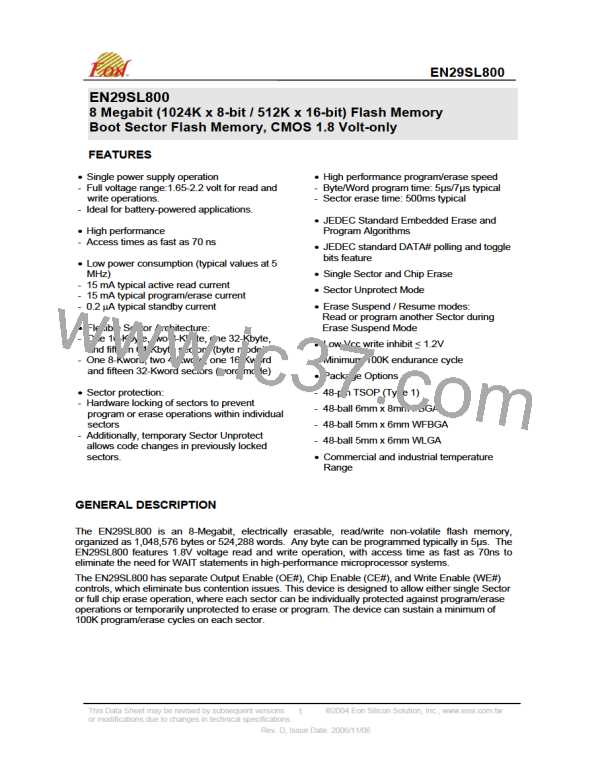EN29SL800
DQ6: Toggle Bit I
The EN29SL800 provides a “Toggle Bit” on DQ6 to indicate to the host system the status of the
embedded programming and erase operations. (See Table 6)
During an embedded Program or Erase operation, successive attempts to read data from the device
at any address (by active OE# or CE#) will result in DQ6 toggling between “zero” and “one”. Once
the embedded Program or Erase operation is completed, DQ6 will stop toggling and valid data will
be read on the next successive attempts. During embedded Programming, the Toggle Bit is valid
after the rising edge of the fourth WE# pulse in the four-cycle sequence. During Erase operation, the
Toggle Bit is valid after the rising edge of the sixth WE# pulse for sector erase or chip erase.
In embedded Programming, if the sector being written to is protected, DQ6 will toggles for about 2
μs, then stop toggling without the data in the sector having changed. In Sector Erase or Chip Erase,
if all selected sectors are protected, DQ6 will toggle for about 100 μs. The chip will then return to the
read mode without changing data in all protected sectors.
The flowchart for the Toggle Bit (DQ6) is shown in Flowchart 6. The Toggle Bit timing diagram is
shown in Figure 9.
DQ5: Exceeded Timing Limits
DQ5 indicates whether the program or erase time has exceeded a specified internal pulse count
limit. Under these conditions DQ5 produces a “1.” This is a failure condition that indicates the
program or erase cycle was not successfully completed. Since it is possible that DQ5 can become a
1 when the device has successfully completed its operation and has returned to read mode, the user
must check again to see if the DQ6 is toggling after detecting a “1” on DQ5.
The DQ5 failure condition may appear if the system tries to program a “1” to a location that is
previously programmed to “0.” Only an erase operation can change a “0” back to a “1.” Under
this condition, the device halts the operation, and when the operation has exceeded the timing limits,
DQ5 produces a “1.” Under both these conditions, the system must issue the reset command to
return the device to reading array data.
DQ3: Sector Erase Timer
After writing a sector erase command sequence, the output on DQ3 can be used to determine
whether or not an erase operation has begun. (The sector erase timer does not apply to the chip
erase command.) When sector erase starts, DQ3 switches from “0” to “1.” This device does not
support multiple sector erase command sequences so it is not very meaningful since it immediately
shows as a “1” after the first 30h command. Future devices may support this feature.
DQ2: Erase Toggle Bit II
The “Toggle Bit” on DQ2, when used with DQ6, indicates whether a particular sector is actively
erasing (that is, the Embedded Erase algorithm is in progress), or whether that sector is erase-
suspended. Toggle Bit II is valid after the rising edge of the final WE# pulse in the command
sequence. DQ2 toggles when the system reads at addresses within those sectors that have been
selected for erasure. (The system may use either OE# or CE# to control the read cycles.) But DQ2
cannot distinguish whether the sector is actively erasing or is erase-suspended. DQ6, by
comparison, indicates whether the device is actively erasing, or is in Erase Suspend, but cannot
distinguish which sectors are selected for erasure. Thus, both status bits are required for sector and
mode information. Refer to the following table to compare outputs for DQ2 and DQ6.
This Data Sheet may be revised by subsequent versions
or modifications due to changes in technical specifications.
©2004 Eon Silicon Solution, Inc., www.essi.com.tw
16
Rev. D, Issue Date: 2006/11/06

 EON [ EON SILICON SOLUTION INC. ]
EON [ EON SILICON SOLUTION INC. ]